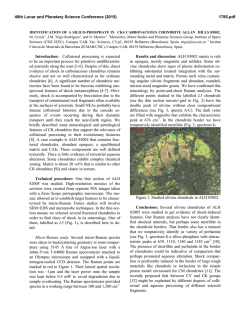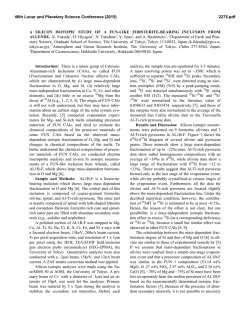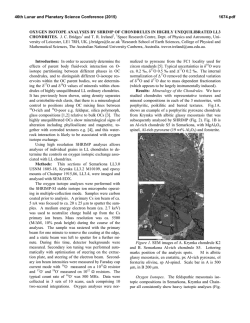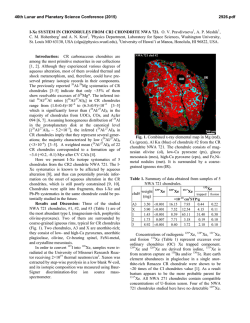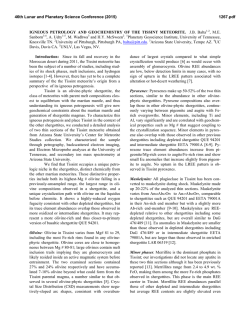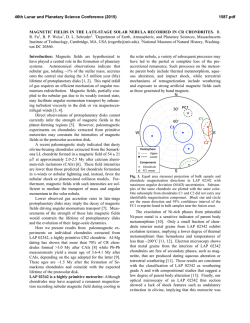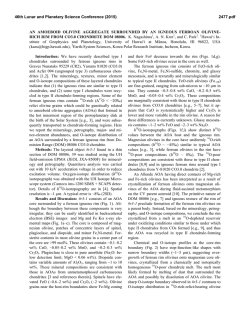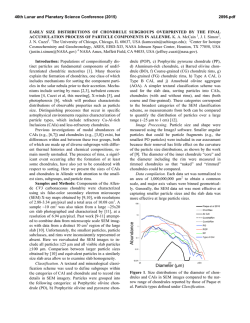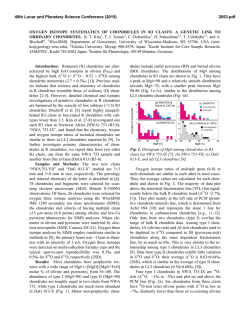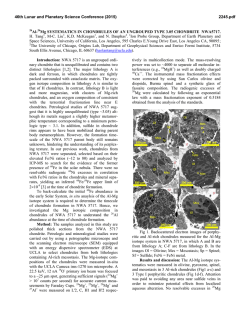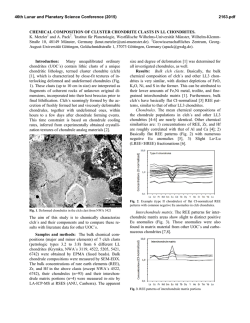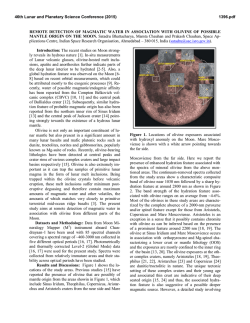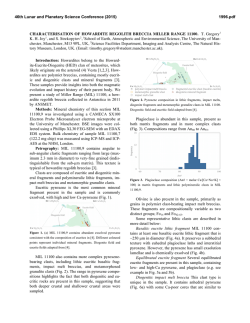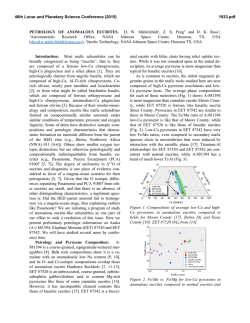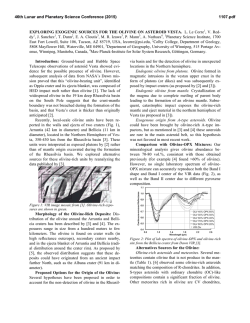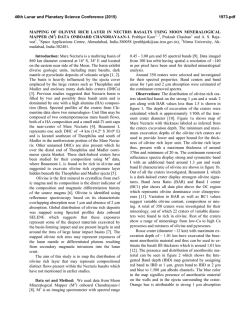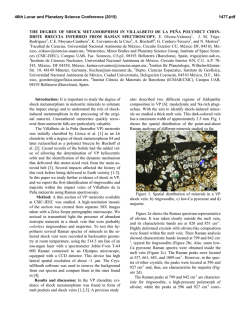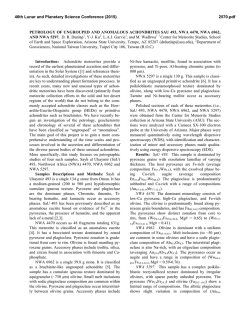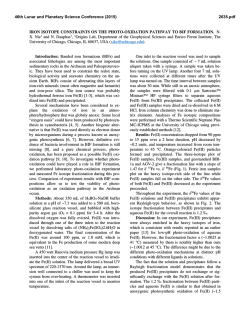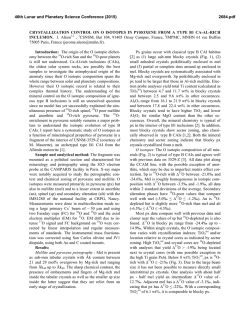
Silicon Condensation in Type 1AB Chondrules at Near Equilibrium
46th Lunar and Planetary Science Conference (2015) 2658.pdf SILICON CONDENSATION IN TYPE 1AB CHONDRULES AT NEAR EQUILIBRIUM CONDITIONS. E. R. Harju,1 I. E. Kohl1, A. E. Rubin1, and E. D. Young1, 1Department of Earth, Planetary, and Space Sciences, University of California, Los Angeles, Los Angeles, CA, 90095-1567, USA ([email protected]). Introduction: Partially or fully molten chondrules could interact with gases present in their environment; evidence of these interactions can be preserved in the isotopic ratios contained in the mineral phases in the chondrules. Olivine is a common component of chondrules and may react with gaseous Si (in the form of SiO) by a reaction similar to: Mg2SiO4 + SiO + H2O → 2MgSiO3 + H2 (1) where gaseous silicon monoxide condenses into a chondrule melt and reacts to form pyroxene. Silicon monoxide gas condensing into chondrule melts is proposed by [1] to interpret oxygen isotope mixing from relict olivine and a gaseous silicon component. The isotopic effects of condensation may also be observable in silicon and magnesium isotopes in chondrules. Isotope effects due to condensation can be calculated using a model developed by [2]: α cond = α Eq α Kin s i Results: Silicon three isotope plots for Chondrule 1 in EET 87770 and Chondrule 1 in EET 92052 are shown in figures 1 and 2. Olivine data are shown in pink ellipses and pyroxene data are shown in black ellipses. The error ellipses represent 1-sigma analytical uncertainties. A silicon isotope terrestrial fractionation line is shown for reference. (2) α Eq ( s i − 1) + α Kin where αcond is the isotope fractionation due to condensation, αEq is the equilibrium isotope fractionation between gas and condensed phase, αKin is the kinetic isotope fractionation including collision frequency and zero-point energy effects [3], and si is the partial pressure of gaseous species i divided by the equilibrium partial pressure of of gas i (a measure of the degree of undercooling in the system). Samples and Methods: Type 1AB chondrules containing pyroxene rims and interior olivine phenocrysts were selected for the study to determine if there is an isotopic signature of condensed silicon-bearing gas in the pyroxene. Silicon isotopes were previously measured using UV laser ablation and MC-ICPMS at UCLA in type 1AB chondrules in an Allende (CV3) chondrule [4] and two chondrules in Elephant Moraine (EET) 87747 (CR2.8) [5]. Here, two additional type 1AB chondrules were selected for study in sections of EET 87770 and EET 92052 (both CR2.8). X-ray maps of Si, Mg, Ca, Al, and Fe were used to differentiate pyroxene, olivine, and other phases in the chondrules. The identity of the mineral phases analyzed by LA-MC-ICPMS were confirmed by EDS. Figure 1. Silicon three isotope plot for EET 87770 Chondrule 1. Olivine analyses are shown in pink and pyroxene analyses are shown in black. Error ellipses represent 1-sigma analytical uncertanties. Figure 2. Silicon three isotope plot for EET 92052 Chondrule 1. Olivine analyses are shown in pink and pyroxene analyses are shown in black. Error ellipses represent 1-sigma analytical uncertanties. Probability density plots are used to determine if there is a fractionation in δ29Si between interior olivine and rim pyroxene phases. Probability density plots of δ29Si measured in olivine and pyroxene phases for EET 87770 and EET 92052 are shown in figures 3 and 4. Olivine data are shown in black and pyroxene data are shown in gray. 46th Lunar and Planetary Science Conference (2015) Figure 3. Probability density plot for δ29Si measured in olivine (black, n=7) and pyroxene (gray, n=10) in EET 87770 Chondrule 1. Figure 4. Probability density plot for δ29Si measured in olivine (black, n=1) and pyroxene (gray, n=3) in EET 92052 Chondrule 1. Discussion: Isotopic fractionation expressed as differences in δ29Si between olivine and pyroxene attributed to condensation of a silicon-bearing gas was observed in one chondrule in Allende [4] and one of two chondrules in EET 87747 [5]. If the isotope fractionation is due to the condensation of silicon-bearing gas, then the process happened at near equilibrium conditions with an undercooling of less than 3 K. Our new data for the two additional CR type 1AB chondrules do not show a distinct difference in δ29Si between pyroxene and olivine. In EET 87770 Chondrule 1 the δ29Si data for olivine and pyroxene are overlapping. EET 92052 Chondrule 1 is highly fractured and has a limited area that was suitable for data collection. The pyroxene data exhibit a bimodal distribution with one pyroxene analysis plotting near the olivine analysis point. This pyroxene analysis is adjacent to an olivine grain and some olivine may have been ablated in this analysis, but the pit bottom is pyroxene as revealed by inspection by SEM. Due to the 2658.pdf limited amount of data available it is difficult to determine if there is indeed a fractionation for δ29Si between pyroxene and olivine in this chondrule. Distinct isotopic fractionations have been observed in two out of five CV and CR chondrules studied. In chondrules with a distinct isotopic fractionation it was calculated that the fractionation took place due to silicon isotopic condensation at near equilibrium conditions. The chondrules that do not have a distinct δ29Si fractionation between olivine and pyroxene may have still condensed silicon, but at equilibrium conditions that did not produce a non-equilibrium fractionation between δ29Si values in these two phases. There is no clear evidence that all of the type 1AB chondrules studied incorporated a silicon-bearing gas; however, the data do not rule this out. The chondrules most likely inhabited a gas-rich environment which allowed for equilibrium or near-equilibrium isotopic exchange and near-equilibrium silicon isotope ratios. Some areas may have had slight undercooling that produced small silicon isotopic fractionation effects manifested as slight shifts in δ29Si values in pyroxene relative to olivine phases in CR and CV chondrules. References: [1] Chaussidon, M. et al. (2008) GCA, 72, 1924-1938. [2] Young, E. D. and Schauble, E. A. (2012) Meteoritics & Planetary Sci., 47, Abstract #4382. [3] Simon, J. I. and DePaolo, D. J. (2010) EPSL, 289, 457-466. [4] Harju E. R. et al. (2013) LPSC XLIV, Abstract #2908. [5] Harju E. R. et al. (2014) LPSC XLV, Abstract 2829.
© Copyright 2025
